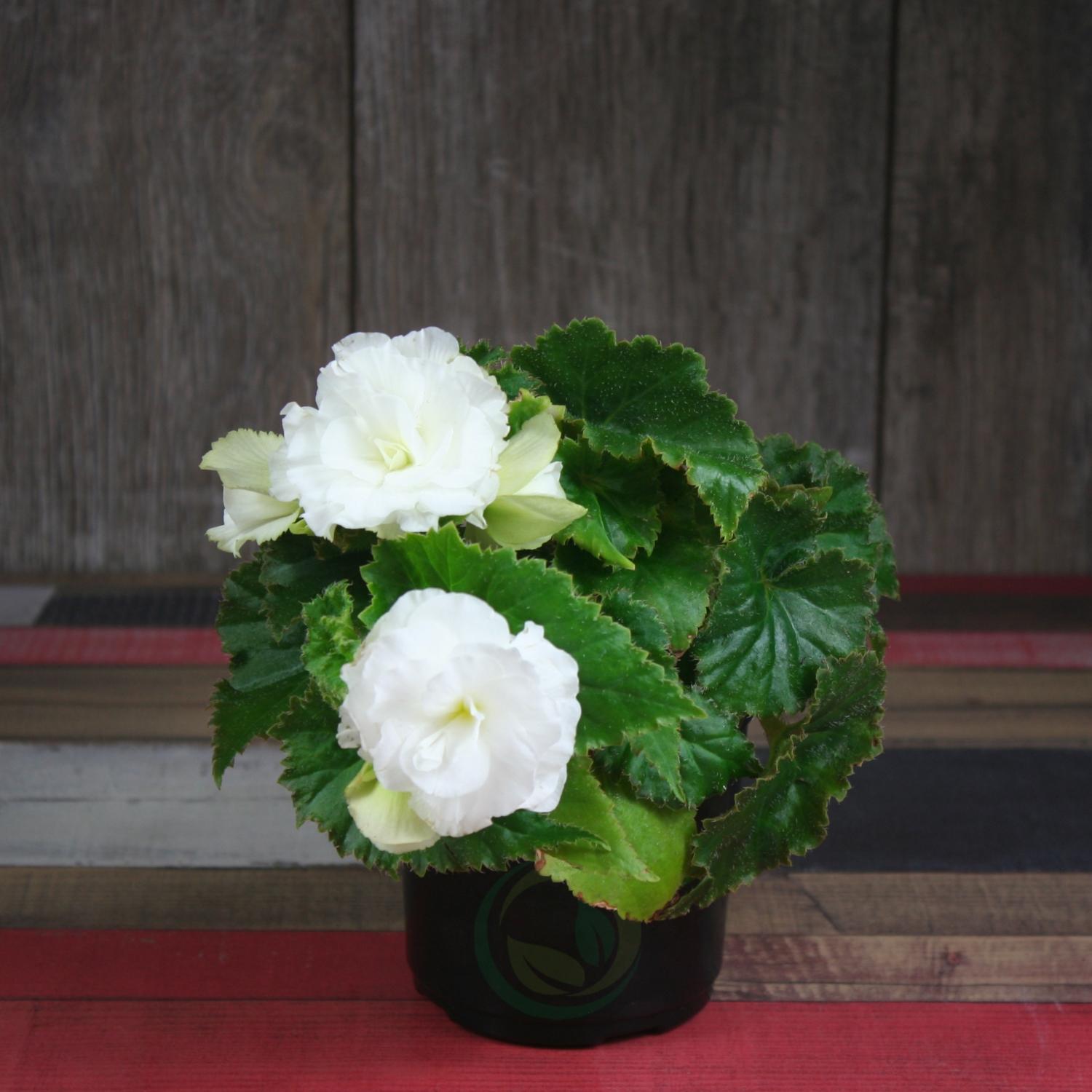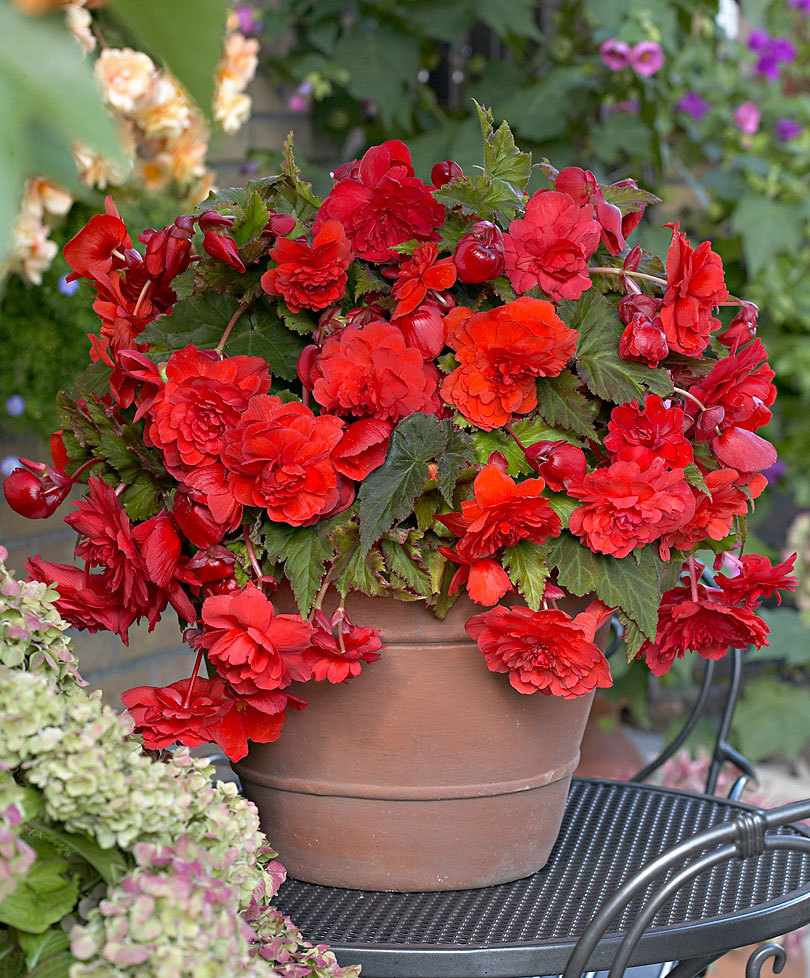Among lovers of planting home flowers, the cultivation of begonias is very popular. It differs from others in a large number of varieties. The texture and shape of the leaves of each begonia is strictly individual; the plant can be painted in a variety of colors.
The beauty of colors is expressed by their palette and lush appearance. Begonia can be completely monochromatic, or it can have a wide variety of colors.
The plant is about 25 cm long. Growing begonia bushes to get a beautiful garden requires special care, especially at home.
Content
Landing nuances
In order to plant a begonia and minimize the work associated with caring for it, it is necessary follow a certain sequence... In the future, this will allow you to achieve good growth and beautiful flowering.
Tuberous begonia is grown in early February and continues until May. The tubers are best planted in slightly damp peat. As a result, begonia will receive the maximum amount of required nutrients. Due to the large amount of peat, the tuber will develop much better.
Each tuber has two sides:
- Rounded;
- Concave.
It is allowed to plant tubers in the soil only round side... Novice gardeners often make mistakes because of the appearance of the tuber and turn it over, planting on the wrong side. Such work of planting a tuber requires care and accuracy.
Tuberous begonias should be planted at room temperature, usually not exceeding 20 degrees, followed by moderate watering. Because of these conditions, tuberous begonia sprouts germinate very quickly. After they reach 5 cm in length, they are transplanted into a flower pot, and its diameter must exceed 20 cm.
The transplanted plant begins to grow vigorously, producing a large number of leaves and flower buds. The plant blooms all summer long and does not wither during the fall. Before the beginning of winter, the leaves fall off the tuberous begonia, it is required to prepare the plant for the winter period.
For this purpose, the leaves are trimmed, roots are taken out... Storage of tubers, roots and leaves should be done in a cool, dark place.
The location of the plant, its lighting
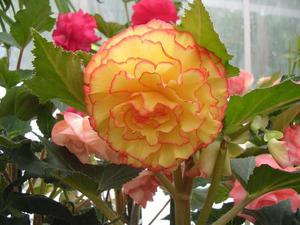 It will be very good if the tuberous plant is placed near the window, on a flower stand, maintaining a southwest direction. If possible, during the winter cold, it is advisable to transfer the plant all the time to the windows of the south side.
It will be very good if the tuberous plant is placed near the window, on a flower stand, maintaining a southwest direction. If possible, during the winter cold, it is advisable to transfer the plant all the time to the windows of the south side.
It is undesirable to get sun rays on begonia leaves in summer. They can get severe burns. For this, the window glass is covered with a film, ensuring that scattered sunlight falls on the begonia.
Irrigation system
In order for the plant to always please the eye, it is necessary to properly organize its watering. Tuberous begonia, planting and care at home, requires special attention.In the summer heat, the tuber should have abundant watering, the plant should not dry out.
At moderate temperatures, it is enough to water the begonia three times a week, in the scorching heat, watering should be daily... This is especially true of the period when intense flowering occurs.
Good watering ensures a strong flowering of begonia, the more beautiful the plant bush will look. It is better to water the plant with settled water.
During watering, water should not get on leaves and flowers. Begonia doesn't like this. There is no need to achieve strong soil moisture. The plant has very delicate roots, so excess moisture can be very harmful.
Before the next watering, you need to make sure that the soil is completely dry. With constant ingress of water on the leaves of the plant, they begin to turn yellow and rot. The plant gradually dies.
When the heat is 40 degrees, to cool the begonia pot, you can put it in a basin for a while, where moist cool stones will be poured.
To keep moisture around indoor begonia preferably humidify the airspraying water. After the begonia has faded, the number of watering is gradually reduced.
What top dressing is needed
This plant is very fond of good fertile land. There should be no lime in the soil. Feeding begonias should be carried out several times a week, starting in summer and ending in late autumn.
Any fertilizer intended for growing indoor plants is suitable for feeding. This soil is sold in gardening shops.
The subtleties of growing
Begonia is a very capricious plant and requires careful maintenance. If this is not done, the plant will not produce a beautiful flower. Most lovers of this plant often face the problem of proper care. It's possible determine by the appearance of begonias:
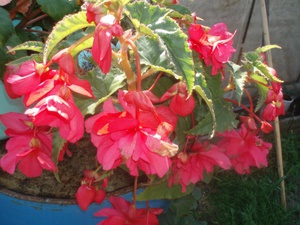 The leaves are dotted with brown spots. This speaks of the burn they received from the scorching sunlight. The flower should be transferred to the shade as soon as possible;
The leaves are dotted with brown spots. This speaks of the burn they received from the scorching sunlight. The flower should be transferred to the shade as soon as possible;- When the sun's rays do not hit the plant, and the brown spots do not disappear, therefore, the plant lacks nutrients, or it suffers from a lack of water. Sometimes, it happens, on the contrary, the plant is simply excessively "flooded" with water;
- If the leaves begin to dry and then fall off, you can talk about the dry air surrounding the plant. This happens most often in early spring. At this time, the heating radiators have not yet been turned off and they give a lot of heat. To remedy the situation, you need to do air humidification.
- When the stem is rotting, the amount of watering should be reduced, their volume should be reduced. Remove all damaged flowers and rotting stems.
How to care for a plant if pests appear
 The appearance of pests is associated with improper care of room begonia.
The appearance of pests is associated with improper care of room begonia.
The most dangerous enemy of begonia is considered powdery mildew... Its appearance is caused by abundant watering. To combat this pest, it is necessary to treat the flower with a fungicide. You can also use a simple solution of garlic. To prevent such a disease from affecting your plant, it is necessary to carry out moderate watering, constantly loosen the soil, and ventilate the premises.
Another pest that infects begonia is aphids. The fight against this infection is done manually. For this purpose, each sheet must be wiped with alcohol. You can use a specialized solution sold in stores, such as Homa. A teaspoon is dissolved in one liter of water. Only begonia leaves can be treated with this solution.
When the indoor humidity is very low, the plant is attacked by spider mite... To combat it, the leaves are treated with chamomile or soapy water. Specialized drugs give a great effect:
- Intavir;
- Karbofos.
How begonias reproduce
The plant can be propagated by seeds or tubers. The finished tuber is divided into several parts. Each of them must have a developed kidney.The finished cut edge is sprinkled with sand. The prepared stalk is planted in the soil, moderately watered. Tuberous begonia, planting and care, requires special care.
A whole tuber can be stored for about five years. Before you start planting it, you need to remove the mold or existing rot marks.
How begonia is transplanted
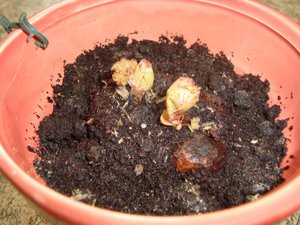 A plant transplant is required only if there has been a strong growth of the root system, and it simply does not fit in the pot.
A plant transplant is required only if there has been a strong growth of the root system, and it simply does not fit in the pot.
It is better to replant the plant in the middle of spring. The flower is carefully pulled out of the pot, the roots are cleaned. Then they are dipped in a light solution of potassium permanganate. Stand for about 20 minutes.
Then completely decayed roots are cut off, the cuts are processed with fine charcoal.
Begonia is planted in a large pot, where the mixture is previously poured into the ground. The plant will hurt at first. Only after a couple of weeks will tuberous begonia begin to take root. In this period requires frequent watering, should not be exposed to hot sunlight. As time passes, your home garden will be decorated with beautiful flowers of home begonia grown from one tuber.
Of course, caring for begonias is a painstaking business that requires great care. A very beautiful flowering will be grateful. If you follow all the conditions of detention, you can arrange a whole blooming garden on the windowsill.
